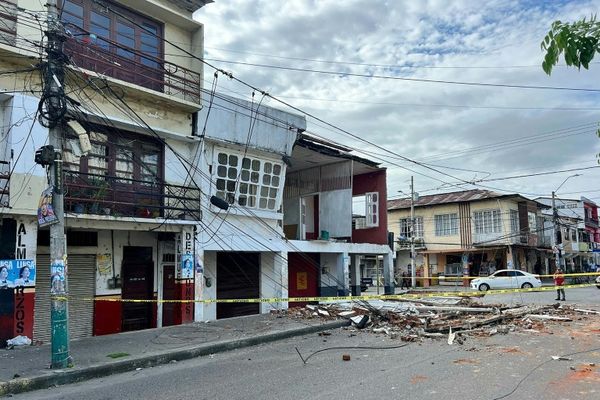
Airbnb cofounder Joe Gebbia describes a house that sounds like a nice spot for an upcoming vacation: it's cozy, with lots of natural light and a high gable ceiling, bespoke custom furniture, and a smart design aesthetic.
Gebbia isn't describing a listing on Airbnb. He's talking about a house he wants to sell. Actually, he wants to sell a lot of these houses; so many, that if he's successful, Gebbia envisions a version of the house—in studio, one-bedroom, and two-bedroom configurations—in backyards throughout California, and eventually the U.S.
Samara, the startup that Gebbia cofounded with former Flex CEO Mike McNamara, has spent years perfecting the design of these houses and is betting that buyers are ready to order them online, to be delivered and installed—pre-assembled—on their property.
“Families across California that need space are looking for these solutions,” Gebbia tells Fortune, citing multigenerational living, the work from home revolution, and homeowners' interest in rental income as among the trends driving the need. “We’re taking the same playbook that Airbnb brought to the travel space of ‘make it simple, make it easy for the consumer,’” says Gebbia, who left his operational role at Airbnb in the summer of 2022 but remains on the board of directors.
Technically the houses Samara is building are what's called ADUs, or accessory dwelling units: a term that encompasses the backyard cottages, casitas, and in-law units that sit alongside some homeowners' primary residence. The idea behind Samara is to mass produce ADUs, making it easy for a homeowner to add one to their property without the headaches of working with a contractor or dealing with the local permitting process. Gebbia likens it to ordering a Tesla electric car online—“You go online, you pick your options, you configure it to your tastes, and you hit order.”
The San Francisco-based company’s initial product—called Backyard—ranges from 420-square feet to 690-square feet, and costs between $269,000 and $369,000. Samara has been quietly offering the homes on its website since last year, fine tuning the process, and with an infusion of capital, now plans to ramp up its sales and marketing efforts.
On Monday, Samara announced that it has raised $41 million in funding in a Series A round led by VC firm Thrive Capital, with participation from a variety of investors including 8VC, General Catalyst, New Legacy, SV Angel, and Airbnb, as well as Michael Dell and Airbnb cofounders Brian Chesky and Nathan Blecharczyk.
The money will help Samara expand its operations, including manufacturing, marketing, and research and development, says Gebbia. “We’ve got to scale a lot of dimensions of the business.”
Building a house inside a factory
Samara is the name of a seed with a wing. The wing—a piece of technology that’s integrated into the seed, as Gebbia describes it—lets the seed fly like a helicopter as it falls from its tree. It's an apt name for a company that began as Airbnb's in-house R&D group back in 2016. In the spring of 2022, the unit was spun out of Airbnb as an independent company, funded by Gebbia and McNamara, along with Airbnb as an investor.
In contrast to the sharing economy principles that let Airbnb thrive by leveraging existing real estate, Samara is very much in the “old” economy business of manufacturing a physical product, with all the messy inventory, supply chain, and transportation challenges that come with it.
It’s a very different ball game, but that’s where McNamara comes in. The former CEO of Flex, a $30 billion-in-revenue electronics manufacturer that assembles everything from laptops to hospital X-ray machines, is well versed in the intricacies of global supply chains. While Gebbia, a graduate of Rhode Island School of Design, talks about the product's atmosphere and ambiance, McNamara speaks in the language of “stacked margins,” “capital outlay,” and “time variance.”
By building the ADUs inside a factory, Samara has a controlled environment that’s not subject to unpredictable weather, while also benefiting from standardized material and production costs, McNamara says. “Our unit is going to be continually more cost effective relative to a general contractor building in the field,” he says.

Samara is working with a long list of suppliers that provide everything from the material for custom kitchen furniture to rooftop solar panels. The company won't divulge much about its production process, but says it has determined that the manufacturing facility must be between 500 miles and 1,000 miles away from a houses’ destination for the model to work. That would allow Samara to cover a decent swath of territory that includes all of California, and some part of the Southwest. To push further into the U.S. sunbelt, as the company eventually hopes to do, McNamara says more facilities would be needed.
The Samara CEO won’t go into details on the company’s financial model but says “we have a very foreseeable timeframe that we can be free cash flow break even.”
Another interesting contrast with Airbnb is that while the short-term home-rental service has caused friction with local governments since its inception, Samara appears to have some favorable regulatory tailwinds blowing its way. As California and other states look for ways to ease the housing shortage, ADUs have become a popular remedy. California has passed several laws in recent years making it harder for local municipalities to block ADU construction on the basis of local zoning codes. Earlier this month, California Gov. Gavin Newsom signed a law allowing ADUs to be sold separately from a property’s main residence, meaning ADUs can now be bought and sold like condos.
Still, even with the help of a service like Samara, adding an ADU to a property is inherently more complex than taking delivery of a new car. The company says the average time from clicking “buy” to getting the keys of one of its homes is about seven months. First, a company representative must visit the property to determine whether it's suitable. After that there's a process of getting permits, taking soil surveys, and completing other preparatory steps—a phase Samara says takes three to four months. The final step—placing the house in a customer's backyard—requires about 30 days, which includes preparing the foundation and setting up the water, wastewater, and electrical lines. Once a crane lowers the house onto the foundation, it takes just an hour and a half to bolt it and connect it, McNamara says.
The fact that the process is such a pain in the butt, McNamara and Gebbia say, is why it's an opportunity; the customer lets Samara handle everything.
A small living space with soul
Whether consumers will want to live in such mass-produced mini dwellings remains to be seen. Gebbia believes the current confluence of societal trends, Samara’s end-to-end handling of the construction and permitting process, and the eye-pleasing design of the Backyard will make the concept click with consumers.
The company worked on four different versions of the product, making various design changes, before arriving at the version of the Backyard that's now on sale. “How do you create a small space that has soul? That's what we were after,” Gebbia says, describing the unit as a “blank canvas” that owners can adjust to their changing needs.
The Backyard has a steel roof, a hardwood floor made of engineered oak wood, and is built from a structure of insulated steel six-by-twos. The interior walls have a drywall-like finish, which means residents can hang pictures, paint the walls, and do any of the other customization projects possible in a normal home. The unit can be connected to the main residence’s electrical system or run on its own solar panels.
Eventually Samara hopes to produce different versions of ADUs for different regions and climates. The current Backyard is designed only for warm weather and is not suitable for snow (no doubt to the chagrin of skiers and snowboarders seeking an option to own cheap mountain lodging). The company has plans to eventually produce a unit suitable for hurricane-prone regions, which would allow it to target markets like Florida.
For the time being, California alone offers a $200 billion total addressable market for ADUs, McNamara says. As the name suggests, Samara’s Backyard product was designed to sit in a residential backyard. But McNamara envisions situations in which customers purchase multiple units to install side-by-side in a recreational facility near a park or as corporate housing. “We’re going to be happy here for a long time,” he says.







